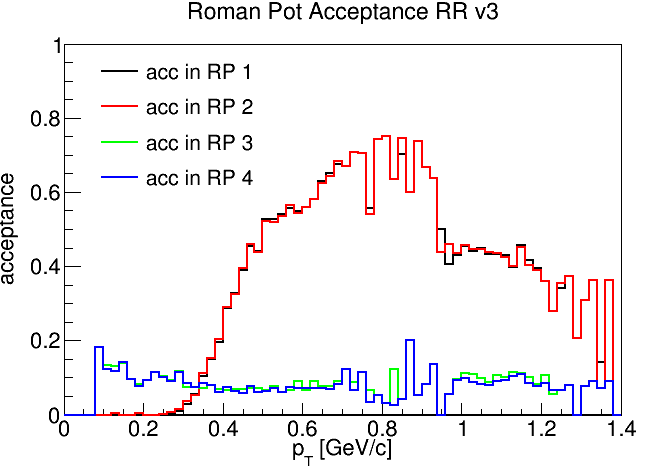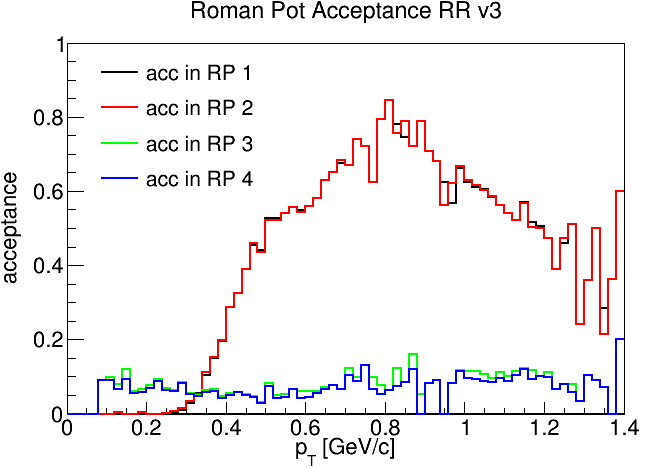e-rhic-ir-l AT lists.bnl.gov
Subject: E-rhic-ir-l mailing list
List archive
- From: Aschenauer Elke-Caroline <elke AT bnl.gov>
- To: "Palmer, Robert" <palmer AT bnl.gov>
- Cc: "E-rhic-ir-l AT lists.bnl.gov" <E-rhic-ir-l AT lists.bnl.gov>
- Subject: Re: [E-rhic-ir-l] Discussion of parameter choices
- Date: Thu, 9 Mar 2017 13:38:18 -0500
On Mar 9, 2017, at 11:38, Palmer, Robert <palmer AT bnl.gov> wrote:
All
Referring to the slides:
https://dl.dropboxusercontent.com/u/71472420/RP_study_with_dispersion_2.pptx
It is clear from the later slides that:
1. from Slide 16 left top: In the assumed input the errors are worse at high Pt because the cross sections fall with pt
2. from slide 16 right middle: We need some data at Pt down to 0.18 GeV/c. Having no data below 0.44 GeV/c is a disaster.
But
3. Slide 19 shows that the loss, of low pt statistics, by a factor of 10, is not a disaster.
4. Slide 17 shows that the loss everywhere by a factor of 10 is much worse.
5. I will conclude, even without the case of a loss of just the high pt, by a factor of 10, that it is worse to lose a factor of 10 at high pt, than the same loss at low pt.
This tells me that even if we do some running with High Acceptance (but lower Luminosity) parameters, to better measure low pt tracks, we may still want also to run with higher luminosity to give better data at higher pt.
But now look at Richard’s earlier results. His slide 9 bottom left, is disappointing, but remember that
a) he does not include the forward calorimeter that will raise the efficiency at the high pt end to near 100%;
and
b) He is using parameters with three times the luminosity assumed in the later slides and my points 1-5; so
c) It shows efficiencies below 0.4 GeV/c of only 7-8 %, but this corresponds about 20% of luminosity times efficiency, while that at higher pt is around 50% x 3 = 150% . With the forward spectrometer, that rises to nearer to 300%. These are both well above that used in the slide 19 example, and not obviously a disaster.
Can this be improved?
Richard is doing an analysis with half the momentum spread. I can make an estimate of what he will conclude by assuming the case when dispersion x momentum spread there dominates over the betatron size. The efficiency then is set just by the area under the xl (outgoing proton moment as fraction of their incoming momenta) with values less than (1.0 - Disp x dp/p). using the distribution from Elke for 20 x 250 GeV, I get
dp/p efficiency Luminosity Product
6.5 e-4 7% 2.89 0.202 1.0
3.25e-4 17% 1.91 0.324 1.6
1.62e-4 34% 1.05 0.357 1.76

I am taking the 7% here to be a confirmation of Richard’s 7-8%. If So, with half the momentum spread (presumably with twice the bunch length) I am expecting him to get around 17%. If I use Mike B’s code for hourglass and crab effects for twice the bunch length, I get Lum=66%. We appear to win by a factor 1.6 giving Lum x eff = 34% below 0.4 GeV/c and something approaching 200 % at the high energy end using the forward spectrometer. These are only rough estimates, but are encouraging.
The alternative approach would be to go back to ‘High Acceptance’ parameters. This would give around 50% at low pt but only 100 % at high pt. This is not obviously an improvement. The loss of high pt data could beat the gain at low pt. More study is needed. Some ideal mix of High Acceptance and High Luminosity might give the best overall performance. At least for the moment, the conclusion is that we have more than one approach; we have the tools; and we will continue the studies.

There is a quite separate question about the relative advantages of higher luminosity using higher divergences in the y direction. The gains with luminosity will have to be balanced by the increased errors in pt measurements with or without transverse momentum dynamic fitting. Again we have the tools and will continue the studies.
Bob
-
Re: [E-rhic-ir-l] Discussion of parameter choices,
Palmer, Robert, 03/09/2017
-
Re: [E-rhic-ir-l] Discussion of parameter choices,
Aschenauer Elke-Caroline, 03/09/2017
- Re: [E-rhic-ir-l] Discussion of parameter choices, Palmer, Robert, 03/09/2017
- <Possible follow-up(s)>
-
Re: [E-rhic-ir-l] Discussion of parameter choices,
Alexander Kiselev, 03/10/2017
- Re: [E-rhic-ir-l] Discussion of parameter choices, Palmer, Robert, 03/13/2017
- Re: [E-rhic-ir-l] Discussion of parameter choices, Palmer, Robert, 03/20/2017
-
Re: [E-rhic-ir-l] Discussion of parameter choices,
Palmer, Robert, 03/30/2017
-
Re: [E-rhic-ir-l] Discussion of parameter choices,
Alexander Kiselev, 03/30/2017
- Re: [E-rhic-ir-l] Discussion of parameter choices, Alexander Bazilevsky, 03/31/2017
-
Re: [E-rhic-ir-l] Discussion of parameter choices,
Alexander Kiselev, 03/30/2017
-
Re: [E-rhic-ir-l] Discussion of parameter choices,
Aschenauer Elke-Caroline, 03/09/2017
Archive powered by MHonArc 2.6.24.